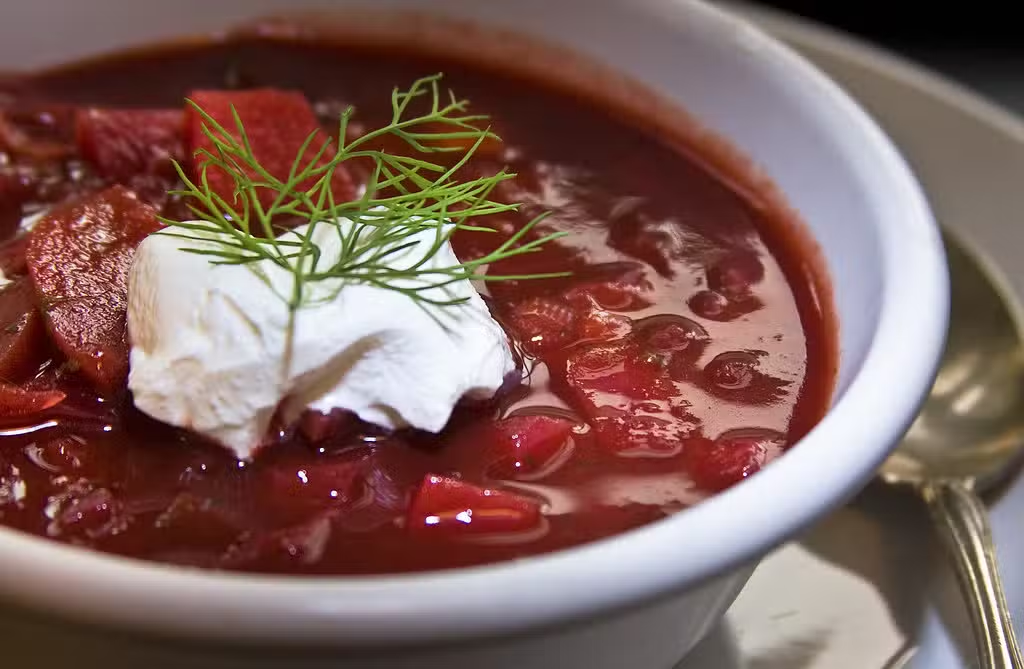Borsch (Борщ) is one of the most popular soups in Central and Eastern Europe and Northern Asia. It is sweet and sour, healthy and can be eaten at any time of year.
It has a complicated and very long history, with the soup changing over time within various geographic regions. Today, the broadly recognized “standard” borsch is made with beetroot and meat stock and is of Ukrainian origin. However, there are so many types of borsch that one can’t really point to any truly defining elements. It always contains vegetables and is optimally served as a thick meal, brimming with ingredients. However, nearly everything else can be changed without losing the name.
Today borsch is found in kitchens, restaurants, and store shelves across Eurasia. It is perhaps best understood as a delicious example of the vast diversity and rich history of that landmass.
How Borsch Got Its Name
(Почему так называется?)
The name “borsch” is an East Slavic term and derives from the proto-Slavic name for hogweed. That vegetable’s pickled stems, leaves, and umbels (flowering canopies) were the soup’s original key ingredient.
Hogweed is most likely called hogweed because it smells of pigs. However, it is valued among foragers and still used by food connoisseurs for its distinct and slightly sweet taste. In addition, in some areas of Eastern Europe, it is still believed to be an aphrodisiac and fertility aid, which might help explain why the dish became such a staple of local culture and why the name was kept even as its namesake was used as an ingredient increasingly rarely.

Many regions and ethnic groups claim some version of borsch as a local traditional dish. Ukraine is regarded as the origin point and its beet-based borsch is generally considered the standard.
Other versions include the rye-based “biały barszcz” (white borscht) of Poland, where it is also known as zurek. There is sorrel-based “зеленый борщ” (green borscht), which is regarded as Ukrainian and sometimes called sorrel soup (щавелевый суп in Russian and щавлевий суп in Ukrainian). “Борщ из капусты” (cabbage borscht) is often attributed to Minnonites living in Ukraine.
“Свекольник,” which literally means “the beet one” in Russian, is a cold borsht generally regarded as Lithuanian in origin. It is beet-based but much creamier and served cold, usually over or with boiled potatoes as a sort of extraordinary sauce. In Lithuanian, it’s called “šaltibarščiai” (pronounced shalt-eh-barsh-chay), which literally means “cold borsht.” Enjoyed across the Baltic coast, Russian generally prefers the name “свекольник” but also uses “летний борщ” (summer borsch), or “холодник” (literally “the cold one”). “Холодник” may have been borrowed from Belarusian or Polish.
Within Russia and Ukraine especially, regional versions of borsch exist. These are, usually variations of the Ukrainian beet-based version, but will differ in what meat, vegetables, and seasonings are used. For instance, “борщ черниговский” (Chernogovsky borscht) is named for a region north of Kyiv, on the Ukraine-Belarus border. The soup features a broth made from meat and bones and adds zucchini and beans to the lineup of vegetables. You can find these regional soups on restaurant menus, internet recipe sites, and store shelves.
Various nuances of language are also revealed in the names for borsch in Russia. For instance, cabbage borsch (Борщ из капусты) is generally the Ukrainian Mennonite recipe mentioned above but “борщ с капустой” (borsch with cabbage) is a beet-based borsch with cabbage added.
There is also some confusion as to how borsch should be spelled in English. “Borscht” is most common, but is actually a transliteration from the Yiddish “באָרשט“ (borscht). This came about because Yiddish-speaking Jews from Eastern Europe first introduced the soup to North America. “Borsch” is also used and is a good approximation of the Russian pronunciation. However, Ukrainian pronounces the final “щ” in borsch as a much more distinct sh-ch, meaning that perhaps the best transliteration would be “borshch.” That variant can be found, but is rare.
How and When Borsch is Eaten
(Как правильно есть борщ?)
Borsch is a staple food in many countries such as Ukraine and Russia and frequently eaten as a regular meal, especially for lunch.
Borsch is typically presented with additional ingredients or side dishes. The eater then finishes the dish preparation before eating or eats the ingredients together as a meal. Similar to many other Eastern European soups, borsch can come with an array of toppings and side dishes.
In Ukraine, borsch is traditionally served with sour cream, fresh greens, and “пампушки“ (pampushki), which are soft garlic rolls. The sour cream is mixed into the soup to taste and the pampushki are dipped in the soup or eaten with the soup and fresh greens. In Russia, pampushki are typically replaced with slices of rye bread which, in turn, are sometimes fried into what then become “гренки.” The bread might be crumbled like croutons, dipped in the soup, or eaten in alternation with the soup and, again, fresh greens.
Borsch also appears in some religious traditions in Eastern Europe. “Memorial borscht,” is traditionally served as the first course at a post-funeral Orthodox wake. The soul of the dead is metaphorically carried to heaven by the steam rising from this and other hot dishes.
In Poland and Ukraine, beet borsch is served on Christmas Eve. Meatless white borsch in Poland is associated with Lent and white borsch made with sausage is for Easter dinner. Eastern European Ashkenazi Jews eat a vegetarian version of borsch during Passover and the Orthodox will make vegetarian beet borsch for Lent.
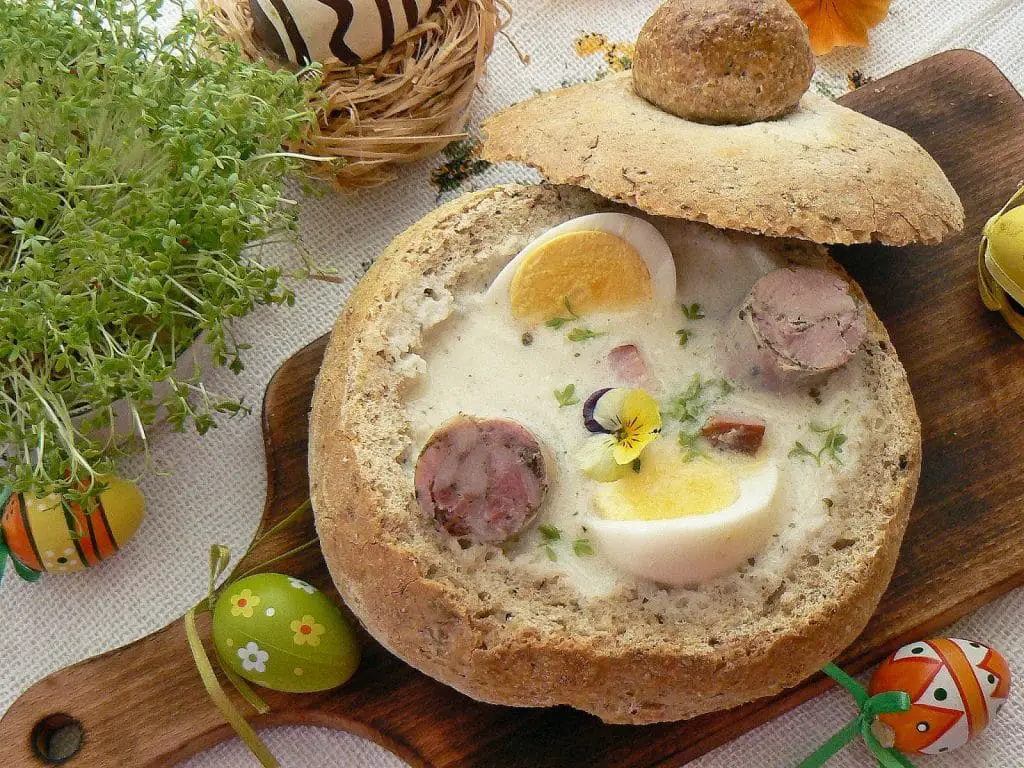
Preparing Traditional Borsch
(Как правильно готовить борщ?)
Obviously, with so much variation, there is no one way to cook borsch. The recipes below will focus largely on beet versions of the dish.
If you are feeling lazy, supermarkets across Eurasia and especially in Ukraine and Russia will have a range of products to help: fully-prepared, frozen or chilled borsch; pre-made borsch starter or concentrate; and frozen or chilled pre-packaged sets of pre-boiled vegetables. Finding borsch when eating out in most of the former Soviet bloc is also easy. In Russia, for instance, it may be found everywhere from fast food places like Teremok to the gourmet White Rabbit.
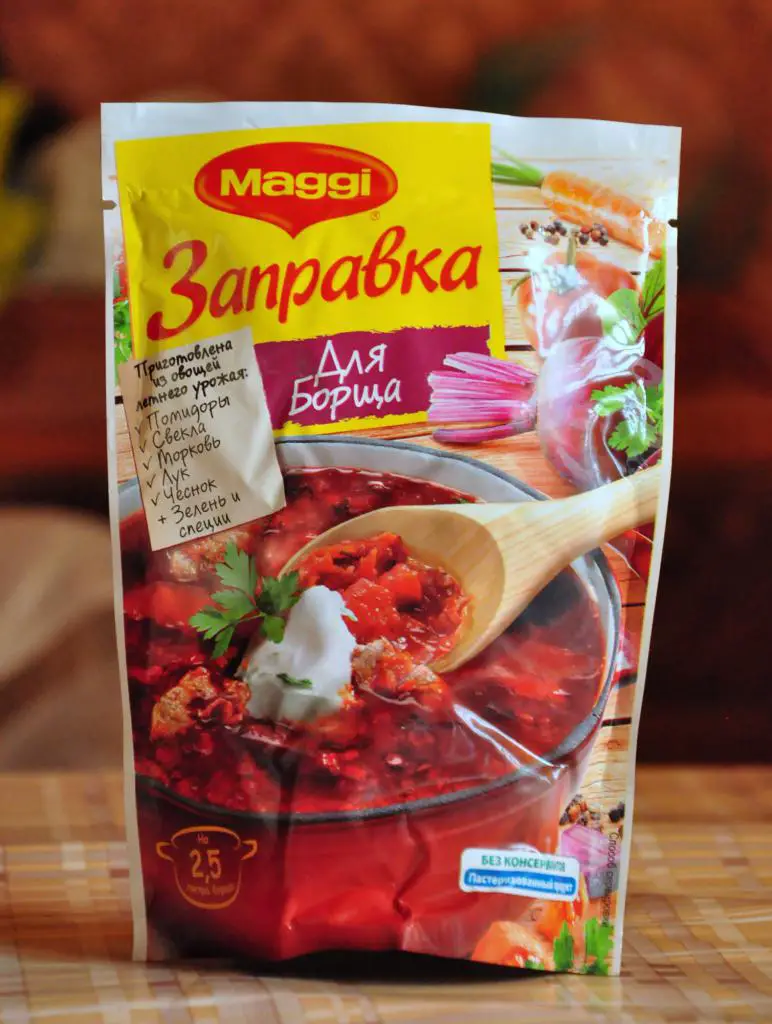
If cooking borsch for yourself, one of the most important steps is to make a good stock. To do this, you start by boiling something. Beef, pork, fish, poultry, or vegetable stock can be used. Sometimes borsch stock is made with a mixture of ingredients. If using meat, make sure to strain off the thick, fatty bubbles as they come to the top. If vegetable broth is preferred, strain the liquid after boiling and before use. This will give a clear, consistent broth.
Many Slavic soups will julienne the vegetables and fry them separately. In Russian, these fried vegetables become what is known as a “заправка,” or “dressing.” They are added to the soup as it cooks. The process caramelizes the sugars in the vegetables and adds flavor. The most typical vegetables to use are cabbage, carrots, onions, and tomatoes.
Borsch also often contains potatoes, but these are usually diced and boiled either in the broth or separately. The beetroot is sometimes boiled and can be used as the stock base. However, sometimes the beetroot is fried, and sometimes rarely) even fermented. Although the beetroot will need time to ferment, usually several days at least, the overall cooking time of the soup can then be decreased significantly. Further, so long as the fermented beet is added to warm soup (and not boiling soup), the soup will be not only extra tart, but also full of probiotics.
Let’s Cook!
(Давай приготовим!)
The below recipes are from The Book of Tasty and Healthy Food, which was published by the Soviet Government and which recorded, standardized, and popularized many traditional foods across the Soviet space. Although the book also changed several of the recipes, mostly to use ingredients then being mass produced in the USSR for the first time, many Russians now recognize the versions of the food as presented in this book as “standard.”
*Note that the recipes below use a general term “кореньев” (root vegetables). It is assumed that any mix of root vegetables may be used here. This includes carrots, which are today the most popular, but also parsnip root, celery root, or others.
| Борщ украинский («Книга о вкусной и здоровой пище» (1952 г.)) |
Ukrainian borsch (from The Book of Tasty and Healthy Food, 1952 ed.) |
| Ингредиенты:
На 500 г мяса:
Приготовление: 1. Сварить мясной бульон и процедить. 2. Очищенные коренья и свеклу нарезать соломкой. Свеклу тушить 20–30 минут, добавив при этом жир, томат-пюре, уксус и бульон (можно влить также хлебный или свекольный квас). 3. Нарезанные коренья и лук слегка поджарить с маслом, смешать с поджаренной мукой, развести бульоном и довести до кипения. 4. В приготовленный для борща бульон положить картофель, нарезанный крупными кубиками, крупно нарезанную капусту, тушеную свеклу, соль и варить 10–15 минут, потом добавить поджаренные с мукой коренья, лавровый лист, душистый и горький перец и варить до тех пор, пока картофель и капуста не будут готовы. 5. Готовый борщ заправить салом, растертым с чесноком, добавить помидоры, нарезанные дольками, быстро довести до кипения, после чего дать борщу настояться в течение 15–20 минут. 6. Разливая в тарелки, положить в борщ сметану и посыпать мелко нарезанной зеленью петрушки. |
Ingredients:
For every 500g of meat:
Preparation: 1. Cook the meat broth and strain it. 2. Chop peeled root vegetables* and beets into small strips. Braise the beets 20-30 minutes, adding fat from the broth, the tomato puree, vinegar, and broth (or bread or beet kvass). 3. Lightly fry the chopped root vegetables* and onion in butter. Add toasted flour to the mix, then dilute it with some of the broth and bring to a boil. 4. To the broth, add potatoes, chopped into large cubes, with coarsely chopped cabbage, the braised beets, and salt. Boil for 10-15 minutes and then add the flour-parsley mixture, bay leaves, all spice, and red pepper. Boil together until the potatoes and cabbage are tender. 5. Season the prepared borsht with the pork fat after mashing it with garlic. Add tomatoes, cut into wedges. Quickly bring to a boil, and then let the borsht set for 15-20 minutes. 6. When pouring the soup onto plates, add sour cream and sprinkle with finely chopped green parsley.
|
| Борщ мясной («Книга о вкусной и здоровой пище» (1952 г.)) |
Meat borsch (from The Book of Tasty and Healthy Food, 1952 ed.) |
| Ингредиенты:
На 500 г мяса:
Приготовление: 1. Сварить мясной бульон. 2. Свеклу, морковь, петрушку и лук нарезать соломкой, положить в суповую кастрюлю, добавить помидоры или томат-пюре, уксус, сахар и немного бульона с жиром (или добавить 1-2 ст. ложки масла), закрыть крышкой и поставить овощи тушить. Овощи перемешивать, чтобы не пригорели, прибавляя, если нужно, немного бульона или воды. 3. Через 15-20 минут добавить нашинкованную капусту, все перемешать и тушить еще 20 минут. 5. Овощи залить подготовленным мясным бульоном, положить перец, лавровый лист, соль, добавить по вкусу немного уксуса и варить до полной готовности овощей. При подаче на стол в борщ положить сметану. 6. В борщ при варке добавляют картофель в целом виде или нарезанный дольками, а также свежие помидоры. Их также нарезают дольками и кладут в борщ за 5-10 минут до окончания варки. В готовый борщ кроме мяса можно положить вареную ветчину, сосиски или колбасу. 7. Для подкрашивания борща можно сделать свекольный настой. Для этого одну свеклу нарезать ломтиками, залить стаканом горячего бульона, добавить чайную ложку уксуса и поставить на 10-15 минут на слабый огонь и довести до кипения. После этого настой процедить и влить в борщ перед подачей на стол. |
Ingredients:
For every 500g of meat:
Preparation: 1. Cook the meat broth. 2. Slice beets, carrots, parsley roots,* and onions into strips. Put in a soup pot. Add tomatoes or tomato puree, vinegar, sugar, and a little broth with the fat (or add 1-2 tablespoons of oil). Close the lid and set the vegetables to braise. Stir the vegetables so as not to burn them. Аdd, if necessary, a little broth or water. 3. After 15-20 minutes, add the shredded cabbage. Мix everything and braise for another 20 minutes. 5. Pour the meat broth over the vegetables. Add pepper, bay leaf, salt, and a little vinegar to taste. Boil until the vegetables are fully cooked. Add sour cream to the borscht as it is served. 6. While the borscht boils, potatoes may be added, either whole or in wedges. Fresh tomatoes may be similarly added. They are cut into wedges and added 5-10 minutes before the cooking finishes. To the finished borscht, in addition to meat, you may add steamed ham, and boiled or smoked sausage. 7. To improve the borscht coloration, you may make a beet extract. To do this, slice the beet, pour a glass of hot broth, add a teaspoon of vinegar, and put it on low heat for 10-15 minutes. Bring to a boil. After that, strain the extract and pour it into the soup before serving. |
| Свекольник («Книга о вкусной и здоровой пище» (1952 г.)) |
Svekolnik – Vegetarian Cold Borsch (from The Book of Tasty and Healthy Food, 1952 ed.) |
Ингредиенты:
Приготовление: 1. Вымыть свеклу, сварить до готовности в воде, добавив лимонной кислоты, затем охладить, очистить свеклу и процедить отвар. 2. Свеклу нашинковать и соединить с отваром, добавить сахар, рубленый вареный белок, нашинкованные салат и лук, а также мелко нарезанные огурцы и заправить сметаной. Перед подачей к столу посыпать свекольник рубленой зеленью. 3. В свекольник можно также положить вареный картофель, нарезанный кубиками, и очищенные свежие яблоки. |
Ingredients:
Preparation: 1. Wash the beets and boil until tender, having added the citric acid, then chill. Peel the beets and strain the bouillon. 2. Shred the beets and add them back to the bouillon with the sugar. Add chopped, cooked egg white, shredded lettuce, green onion, and finally grated cucumber. Add the sour cream. Before serving, top with chopped greens. 3. Boiled, cubed potato may also be added to the svekolnik, as may be peeled, fresh apple.
|
Our Favorite Borsch Videos
This video is made by a Ukrainian-American YouTuber Natasha who runs a channel and a blog called Natasha’s Kitchen. In this video, she shows how to make borsch step by step in English, while giving many useful tricks and tips throughout the video.
Here Russian teacher Veta Chitnev has made a full video as an actual language lesson!
In this video, the host from a Russian YouTube channel called “Кухня наизнанку” or “Kitchen Inside Out” shows how to make three kinds of borsch. She serves them with pampushki. The video has English subtitles available.
You Might Also Like
Kupala is an ancient Slavic holiday celebrating the summer solstice, or midsummer. Once part of a series of annual rituals, it marked and was believed to sustain agricultural cycles—essential to early human survival. Held as vitally important, these pagan traditions remained deeply rooted even after Christianization, technological change, and centuries of oppression tried to dislodge […] Easter breads such as kulich, paska, choreg, and nazuki are delicious Easter traditions. Easter is by far the most important religious holiday for those practicing Eastern Christianity. In addition to church services and egg dying, the holiday is also marked across the cultures by ritual bread baking. Despite the wide geographic area covered by Eastern […] Below, Tajik blogger Roxana Burkhanova describes, in Russian, the place of St. Petersburg in Russian culture. She discusses the city’s history as well as its literary heritage, its nightlife, and even how people from Petersburg speak their own, slightly different dialect of Russian. The text was originally written in 2015 and thus references times before […] Rites of welcoming spring and saying goodbye to winter are some of the oldest holidays preserved across Slavic cultures. In the Baltics, the celebrations were nearly lost after being suppressed by Catholic and imperial dominance. Today, Russia’s Maslenitsa is by the far the best-known, but multiple versions exist across the diverse Slavic landscape. In the […] This extensive list of web resources to assist students learning the Russian language was developed by SRAS and is now hosted on Folkways, part of the SRAS Family of Sites! Disclosure: Some of the links below are affiliate links. This means that, at zero cost to you, we will earn an affiliate commission if you […]
Kupala: Ancient Slavic Midsummer Mythology and its Modern Celebration

Kulich, Paska, Nazuki: The Easter Breads of Eastern Christianity
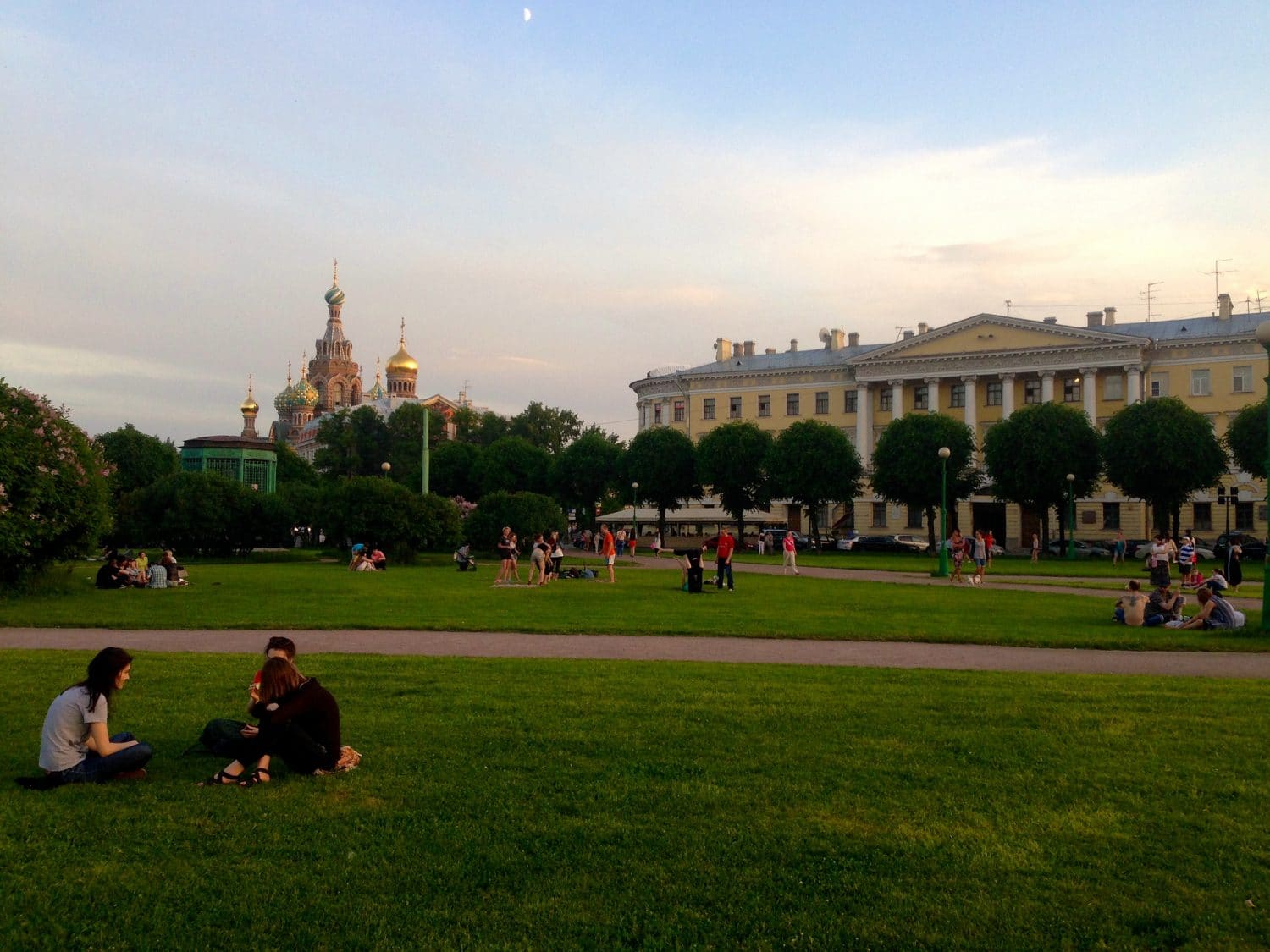
Off to Petersburg, Russia’s Cultural Capital: Моя Россия Blog
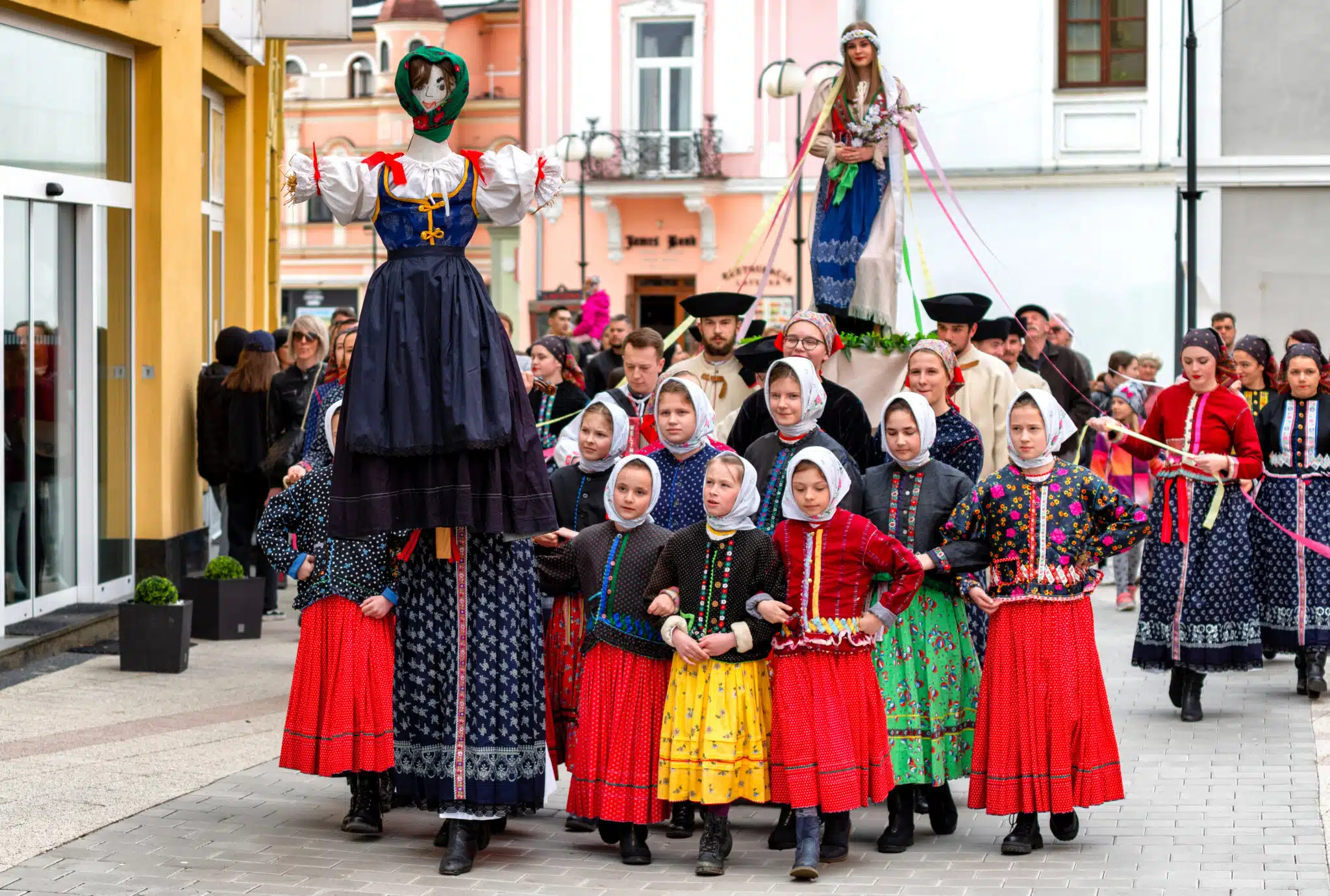
Maslenitsa, Masliana, Meteņi: Spring Holidays of the Slavs and Balts

Resources for Students of Russian

